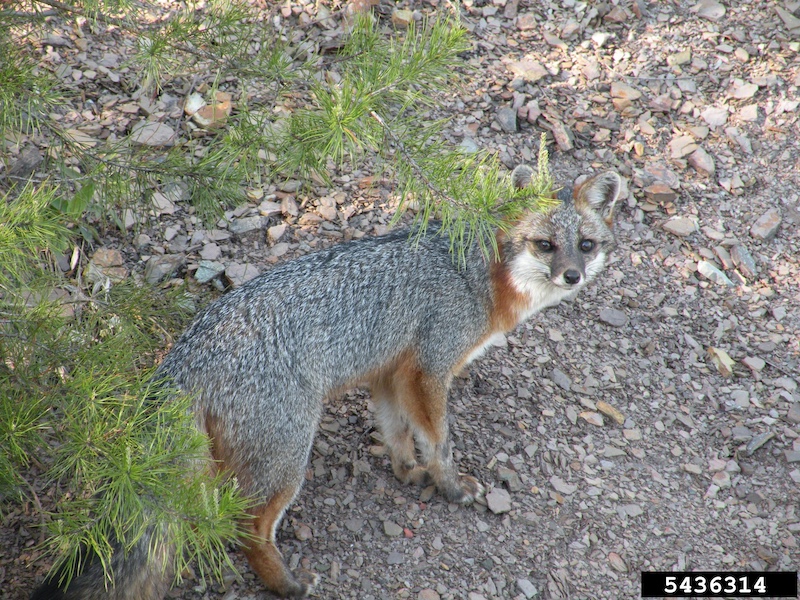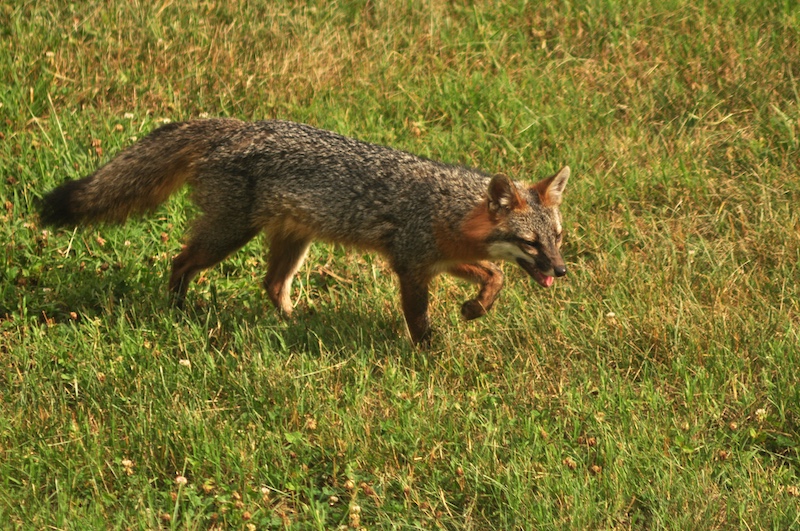
Photo by Tammy Mealman, USFWS.



Photo by Tammy Mealman, USFWS.
Urocyon cinereoargenteus, more commonly known as the gray fox, are the smaller, lighter and less chromatic versions of the red fox. Notoriously elusive and reputed for their ability to climb trees, gray foxes are primarily forest dwellers, preferring wooded habitat that is thick and brushy with a mix of mature forest and brushy areas. As an omnivore, gray foxes eat a mixture of plants and small animals such as squirrels and mice.
Between their agility for climbing trees and their nocturnal habits, most gray foxes go unnoticed. While they can be found throughout the state of Illinois, gray foxes are most common in southern Illinois and along major river corridors. As the only North American canid with the ability to climb trees, gray foxes have the advantage over their red counterparts when it comes to hunting for food or evading predators.
Unfortunately, in the last few decades or more there has been a noticeable decline in gray fox populations. Diseases like canine distemper and competition with coyotes have likely contributed to the population decline. For more information on the factors contributing to the decline of gray fox numbers in Illinois, check out this OutdoorIllinois Journal article.
Two doctoral students from Southern Illinois University-Carbondale (SIU-C) are studying this elusive species to determine what is causing the decline.
The research is building on previous work to monitor and record the distribution, abundance and activity of gray foxes in Illinois. The first project was conducted from 2008 to 2010 using camera traps to record gray fox activity across 16 counties in southern Illinois. Then in 2022, researchers placed 450 camera traps at 150 of the same locations to see what had changed. Between 2022 and 2025, they took more than 200,000 photographs with only .09 percent showing a gray fox. Also shocking, researchers noted that in the 12 years between placing the camera traps, gray fox occupancy across the study area declined four-fold.
As the old adage goes, a picture is worth a thousand words. In this case, the lack of gray fox photos speaks volumes. While this research is ongoing, now with collaring efforts and more in-depth studies on Illinois’ gray foxes, there is an obvious decline and a need to better understand and protect this native species.
This is where Illinois Department of Natural Resources (IDNR) Furbearer (Wildlife Diversity) Program Manager, Stan McTaggart, stepped in. During the 2024-2025 trapping season, McTaggart looked at all available data: hunter and trapper harvest data, Archery Deer Hunters Survey trends and SIU-C research project findings. Collectively this information pointed to a significant and continued decrease of gray foxes.

McTaggart drafted a proposal to close the Illinois gray fox season which required IDNR to seek a legislative change to the Wildlife Code. The Wildlife Code previously stated that there ‘will’ be an annual season for gray fox set by the Director between November 1 and February 15. A change was needed to remove ‘will’ and insert ‘may,’ which would allow IDNR to close (or open) the season completely if the population trends and survey data warranted it. This change gives the IDNR Director the ability to manage the gray fox season based on the most current information.
The changes to the Wildlife Code were proposed and HB 3760 passed through Illinois’ House and Senate with strong support from diverse conservation groups, including the Illinois Trappers Association and legislators across the state. The bill was signed by Governor JB Pritzker on June 30, 2025, and on July 9, 2025, Emergency Administrative Rules were filed to close the hunting and trapping seasons.
For IDNR managers, following the data and survey trends for wildlife species is nothing new. Decades of research and surveys on river otter and bobcat populations led to opening managed seasons for both of those species in 2012 and 2016, respectively. Populations of both species continue to be monitored and are thriving across the state. In 2024, the number of bobcat permits was increased after research and survey trends showed the bobcat population was still increasing. Unfortunately, gray fox are declining and the data suggests that it is time to remove this furbearer from the list of furbearers that can be hunted or tapped. The gray fox population will continue to be monitored, and the season can be re-opened if data indicate they have increased and are doing well.
But what can we do to increase the population of these unique furbearers? With the once-abundant species in decline, researchers, biologists and program managers across the Midwest look to do just that. As is often the case with wildlife, there is rarely a simple answer. Researchers continue to study gray fox in Illinois, Indiana, Iowa and Ohio to try and determine how to reverse this regional decline.

Even though there is no evidence to suggest harvest from hunting or trapping have contributed to the decline, Program Manager Stan McTaggart says he feels it’s the right thing to do in Illinois.
“Solid data from research and surveys is the basis for improving the management of any species,” McTaggart explained. “Even though the annual harvest of gray fox is very low and harvest has not played a role in the decline, I believe we need to take this step to limit any additive mortality. Quite a few hunters and trappers have voiced their concerns about the decline of gray fox populations in Illinois. This change alone won’t solve the issue, but it raises awareness of the current status of gray fox populations and is a reasonable first step until we have more information.”
By closing the gray fox season managers hope to increase survival and reproduction within the scattered habitat pockets where gray foxes exist in Illinois. Depending on what researchers find, some habitat management practices could be implemented to help the population rebound.
“We will continue to look for information that we can use to benefit this unique species,” McTaggart said. “The goal is to figure out what is happening and reverse the decline so that encountering a gray fox can once again be a common experience across Illinois.”
Kaleigh Gabriel jest specjalistką ds. edukacji przyrodniczej (Wildlife Outreach Specialist) w Lewis and Clark Community College, pracującą w budynku Departamentu Zasobów Naturalnych Illinois, gdzie wspiera Division of Wildlife Resources. Dorastając na pograniczu hrabstw Sangamon i Christian, spędzała wiele czasu na polowaniu i wędkowaniu w Illinois. Uzyskała licencjat z pisania/dziennikarstwa na Manchester University w Indianie.
Prześlij pytanie do autora